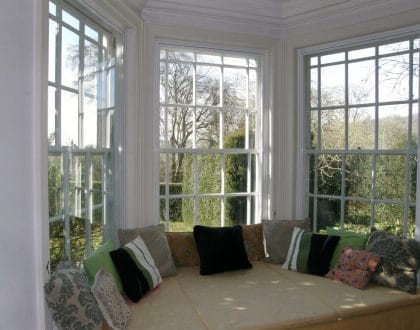Our Simple Guide To Secondary Glazing

by Narzema Arif
Secondary glazing is an effective way to improve the energy efficiency, sound insulation, and security of your home by adding an extra layer of glazing to your existing windows. Here’s a simple guide to help you understand and implement secondary glazing in your home.
Benefits of Secondary Glazing
- Energy Efficiency: Reduces heat loss, leading to lower energy bills.
- Sound Insulation: Significantly reduces noise from outside.
- Security: Adds an extra layer of protection.
- Condensation Reduction: Helps prevent condensation build-up on the primary window.
- Preservation: Suitable for listed buildings and conservation areas.
Types of Secondary Glazing
- Lift-Out Units: Easy to remove and replace, ideal for windows that need occasional access.
- Fixed Units: Permanently fixed, suitable for windows that do not require regular opening.
- Sliding Units: Allows you to open and close the secondary glazing, perfect for sash windows.
- Hinged Units: Operates like a door, good for casement windows.
Materials
- Glass: Provides better sound and heat insulation, and is a high quality long term solution.
- Aluminium: Heavy duty and long lasting solution and also adds a thermal and acoustic barrier
Installation Steps
- Measure the Existing Window: Accurate measurements are crucial for a proper fit.
- Choose the Type of Secondary Glazing: Based on your needs (e.g., fixed, sliding, hinged).
- Prepare the Window Area: Clean the window and surrounding area.
- Fit the Secondary Glazing Frame: Install the frame or track system inside the existing window reveal.
- Install the Glazing Panel: Secure the glazing panel into the frame or track system.
- Seal the Edges: Use appropriate sealing materials to ensure an airtight fit.
Maintenance
- Cleaning: Clean both the primary and secondary glazing regularly to maintain clarity.
- Check Seals: Periodically check the seals to ensure there are no gaps that could allow draughts or noise.
Cost Considerations
- Initial Cost: Depends on the type and material chosen.
- Long-Term Savings: Reduced energy bills due to better insulation.
DIY vs. Professional Installation
- DIY: Suitable for simple installations and those confident in their DIY skills.
- Professional Installation: Recommended for complex installations or if unsure about the DIY process.
Tips
- For assistance in fitting your secondary glazing you can read our installation guide here.
- Opt for glass secondary glazing for better sound and thermal insulation.
- Check for any local regulations or restrictions if you live in a listed building or conservation area.
Secondary glazing is an effective way to improve the thermal efficiency, noise reduction, and security of your windows without the need for full replacements. By understanding the types, materials, installation processes, and maintenance requirements, you can choose the best secondary glazing option for your needs. If this sounds like something for you request a Fast Quote here.
Recommended Posts

Top Tips For Soundproofing Your Bedroom
08/07/2025


